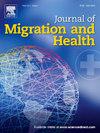居住在香港的南亚散居妇女贫血的患病率和决定因素:一项探索性横断面研究
IF 2.9
Q1 PUBLIC, ENVIRONMENTAL & OCCUPATIONAL HEALTH
引用次数: 0
摘要
背景:对南亚社区,特别是妇女和移民人口来说,贫血一直是一个重大的公共卫生挑战。尽管在发达的西方国家进行了大量的研究,但在城市化的亚洲国家进行比较的证据却非常少。本研究旨在评估在亚洲经济发达的香港居住的南亚妇女贫血的患病率和社会决定因素。方法:在2022年6月至2023年12月期间,通过对675名未怀孕的南亚成年妇女进行人体测量和生物医学测量,以及对自我报告的社会人口统计学、生活方式和健康因素进行调查,招募了675名非怀孕的南亚成年妇女。采用多变量有序逻辑回归来确定贫血严重程度的预测因子。结果轻度和中度/重度贫血(血红蛋白≤12 g/dL)的发生率分别为26.8%和31.4%。研究结果支持良好的饮食质量对贫血严重程度的独立保护作用(高饮食质量与低饮食质量相比,aOR=0.40 [95% CI = 0.22, 0.73]),育龄妇女(35-44岁年龄组与最年轻年龄组相比,aOR=2.36[1.03, 5.44]),家庭人口较多(aOR=1.11[1.01,1.21]),在香港居住的时间较长(aOR=1.83 [1.07, 3.13]);相比<;3年)与更严重的贫血相关。结论香港南亚妇女,尤其是育龄妇女,贫血的高患病率部分归因于营养、文化适应和对大家庭的文化偏好,而不是潜在的遗传易感性。本文章由计算机程序翻译,如有差异,请以英文原文为准。
Prevalence and determinants of anaemia in South Asian diaspora women residing in Hong Kong: An exploratory cross-sectional study
Background
Anaemia has been a significant public health challenge for the South Asian community, in particular women and migrant populations. Despite abundant research in developed Western settings, evidence in urbanized Asian settings is extremely scarce for comparisons. This study aims to assess the prevalence and social determinants of anaemia in South Asian women residing in Hong Kong, an advanced economy in Asia.
Methods
Between June 2022 and December 2023, 675 non-pregnant South Asian adult women were recruited through territory-wide outreach health assessments for anthropometric and biomedical measurements, in addition to a survey on self-reported sociodemographic, lifestyle, and health factors. Multivariable ordinal logistic regression was employed to identify the predictors of anaemia severity.
Results
The observed prevalence of mild and moderate/severe anaemia (haemoglobin level <12 g/dL) were 26.8 % and 31.4 %, respectively. Findings supported the independent protective role of better diet quality against anaemia severity (aOR=0.40 [95 % CI = 0.22, 0.73] for high diet quality compared to poor diet quality), and that women of reproductive age (aOR=2.36 [1.03, 5.44] for the 35–44 age group compared to the youngest group), having a larger household size (aOR=1.11 [1.01,1.21] per person increase), and staying for a longer period in Hong Kong (aOR=1.83 [1.07, 3.13] for > 7 years compared to < 3 years) were associated with more severe anaemia.
Conclusion
The high prevalence of anaemia in our sampled South Asian women in Hong Kong, especially those of reproductive age, was partly attributable to nutrition, acculturation, and cultural preference on larger family size, beyond potential genetic predisposition.
求助全文
通过发布文献求助,成功后即可免费获取论文全文。
去求助
来源期刊

Journal of Migration and Health
Social Sciences-Sociology and Political Science
CiteScore
5.70
自引率
8.70%
发文量
65
审稿时长
153 days
 求助内容:
求助内容: 应助结果提醒方式:
应助结果提醒方式:


